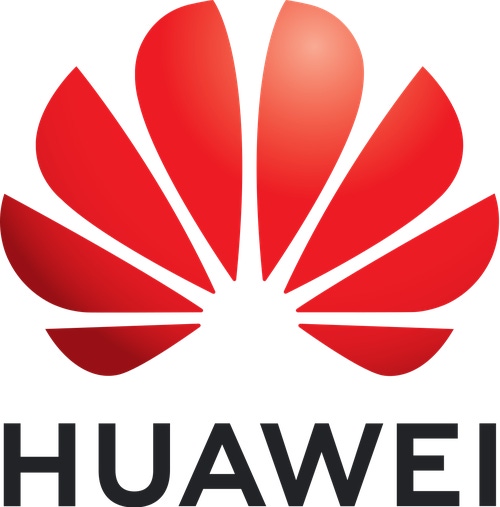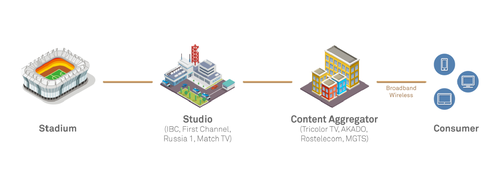Private Line Transformation for Media and Broadcast Service, Operators' New Blue Ocean Market
Forming the network infrastructure of the video industry, private lines for media and broadcast services have many potential high-value customers that represent an untapped revenue source for operators.
December 13, 2018

High-definition (HD) or ultra-high-definition (UHD) video signals are essential to meet increasing consumer demands on content and experience. Higher rates are needed to bear HD/UHD signals, which in turn drives the upgrade of private lines for media and broadcast services. Forming the network infrastructure of the video industry, private lines for media and broadcast services have many potential high-value customers that represent an untapped revenue source for operators.
From camera to screen
Not only did the 2018 World Cup keep fans glued to their screens, the event also provides a good way to show how audio and video signals arrive on the viewer’s screen from the camera lens.
Figure 1:  Signal distribution process in Russia
Signal distribution process in Russia
In each venue (12 in total), 37 UHD 4K HDR (15 Gbps native signals in total) cameras collected signals and communicated with the International Broadcast Center (IBC) in Moscow. This enabled public TV signals to be produced and media-oriented materials to be distributed. Russian TV stations with broadcasting rights, such as First Channel, Russia 1, and Match TV, obtained the public signals and materials for post-production, for example, editing, dubbing, and inserting ads.
This is first-stage distribution, or the contribution, of media and broadcast service signals where original video signals, live broadcasts and program photography are sent from a signal collection venue such as a stadium or TV base to the production studio. Alternatively, original video signals are distributed between multiple production studios for collaborative production. The main players are TV stations and live broadcast companies, such as the BBC and IMG studios, a production company for the Premier League.
TV stations then distributed the completed World Cup programs to the video program aggregator and distributors, including Tricolor TV, AKADO, Rostelecom, and MGTS.
This distribution of the video and audio signals is called primary distribution. Signals are distributed from production studios, for example, TV stations or film and TV companies, to content aggregation and distribution providers such as cable TV, IPTV, OTT, and satellite providers. The main players are TV stations such as the BBC, CNN, CCTV, and Sky.
After obtaining program content, the video distributors transcode and adapt the video and audio, and then distribute the content to subscribers.
This distribution of video and audio signals is called secondary distribution. Signals are distributed from content aggregation and distribution providers to subscribers.
For secondary distribution, the main players are multi-service operators (MSOs), telecom operators, satellite TV service providers, and OTT providers. They purchase, aggregate, and deliver content to subscribers, and generally operate self-built and self-used networks.
To achieve contribution and primary distribution, private lines and networks are built for content producers, including broadcast and TV stations. Broadcast and TV stations themselves focus on content production and lease and purchase private line and network services from third-party operators, which undertake network construction and maintenance tasks.
The contribution and primary distribution of media and broadcast service signals are oriented towards video producers and distributors. Therefore, these are the typical application scenarios where operators provide media and broadcast services with private lines or networks.
The distribution of video and audio signals from camera to screen imposes high requirements on the bandwidth, reliability, latency, and O&M automation of the transport network. Professional service providers are required to provide private line services.
Increased replacement of private lines
Currently, the data collected by cameras is generally outputted through the serial digital interface (SDI). The original video content is transparently transmitted to production studios without being compressed. Compression isn’t used because it can affect post-production and compromise the original content. Uncompressed original video content helps simplify and standardize the IT systems of production studios. However, uncompressed content results in a tenfold or more increase in the volume of transmitted data, creating huge bandwidths requirement on the entire transport network.
In addition, new video technologies are changing the way people consume media and broadcast services. From SD to HD to UHD (4K and 8K) and 360-degree panoramic VR, people expect more from resolution, frame frequency, color depth, and channel improvements.
As a leading organization in the media and broadcast industry, the Society of Motion Picture and Television Engineers (SMPTE) has defined video and audio signal standards. From the traditional SD-SDI to today's mainstream HD/UHD, the video signal rate has increased from 10- to 40-fold.
Standard | Name | Bitrate | Example Video Format |
SMPTE 259M | SD-SDI | 270 Mbit/s | 480i, 576i |
SMPTE 344M | ED-SDI | 540 Mbit/s | 480p, 576p |
SMPTE 292M | HD-SDI | 1.485 Gbps | 720p, 1080i |
SMPTE 372M | Dual Link HD-SDI | 2.970 Gbps | 1080p60 |
SMPTE 424M | 3G-SDI | 2.970 Gbps | 1080p60 |
SMPTE ST-2081 | 6G-SDI | 6 Gbps | 1080p120, 2160p30 |
SMPTE ST-2082 | 12G-SDI | 12 Gbps | 2160p60 |
SMPTE ST-2083 | 24G-SDI | 24 Gbps | 2160p120, 4320p30 |
SD-SDI signals have given way to 1.5 Gbps HD-SDI (720p and 1080i) and 3 Gbps 3G-SDI (1080p) signals. 4K/UHD cameras (running at a rate of 12 Gbps or higher) are becoming the go-to choice for boosting user experience.
Broadcast and TV companies are also increasing UHD programs for popular sports events and live broadcasts by using more cameras and generating more content. As a result, the volume of audio, video, and data being transmitted from venues is increasing. To transmit the Premier League, for example, BT provides private lines from 20 venues to the IMG Studio for remote production and to transmit live, uncompressed HD signals. During each game, 20 to 34 cameras are provided for the multi-angle capture of uncompressed HD video signals.
In 2017, the number of signal channels in a match venue was 24, 20 channels of HD 1.5 Gbps signals and 4 channels of 150 Mbit/s signals, up from the initial 10 to 12 channels. Total bandwidth was 30 Gbps. Thus, separate routing was needed to improve reliability, which requires 60 Gbps of bandwidth for each venue.
Broadcast copyright purchasers now expect better event signals. For example, Sky requires 4K signals and VR live broadcast for Premier League, and thus a higher network rate is required for capacity expansion.
The requirements for better SDI signal rate and user experience both necessitate an increase in the speed and capacity of WAN interconnection interfaces and also underline the need for higher SLAs for private lines. To meet these requirements, traditional private lines must be upgraded.
Larger network bandwidth:Traditional 10G WDM networks cannot support HD/3G-SDI or future-oriented UHD 12G/24G-SDI evolution, because 4K/8K and higher bandwidth requires a single wavelength at 100G/200G.
Higher reliability: The 99.9% reliability and robustness of DWDM ring networks lack sufficient protection capabilities. At least 99.99% is required to ensure less than 52 minutes of downtime per year.
Lower service latency: Traditional network architecture is complex, with a variety of devices. Both signal conversion and compression negatively affect E2E service latency and stability. As a result, signal distortion and damage occur, especially in live broadcasts. To ensure lossless transmission of HD video signals and cut costs, network architecture must be simplified and a transport solution that guarantees low latency and zero packet loss provided. A major player in the industry in Germany, for example, requires less than 5 ms latency to improve user experience.
Automated service provisioning and visualized O&M: Services used to be provisioned by manual connections, resulting in low efficiency, lengthy service provisioning, network invisibility, and complex O&M. SDN provides agile and automated service provisioning and flexible adjustment capabilities, which speeds up service provisioning. SDN also visualizes network resources and service performance and simplifies O&M.
Enhanced security: To ensure copyright protection and enhance content security, service-independent physical-layer encryption is provided.
Traffic growth boosts development potential
Potential high-value customers are widely distributed because every country has requirements for upgrading its private line and networks for media and broadcast service transmission. An extremely reliable transport network is required to collect content at the front end, transmit it back to the production studio, enable collaborative video production among multiple branches, and ensure back-end video content distribution and broadcasting. The market potential is huge.
Media and broadcast service customers are widely distributed, and the blue ocean market space is huge:
− State-owned/commercial TV stations, and broadcast and TV companies
− Large-scale events, such as the Olympic Games, World Cup, European Cup, Asian Games, Commonwealth Games, and Europe's big five football leagues, are increasing the deployment of Fiber to Venue and remote production.
− Professional video and image editing and production companiesOf the top TV stations that provide media and broadcast services, more than 20 national TV stations are located in Western Europe. Each TV station has a private network built to transmit outside broadcasting signals back to production studios for remote production.
Alternatively, the private network is used for WAN interconnection between multi-facility production studios, interconnection between video and audio data centers, and data archiving. Here are some examples:
− In 2016, the BBC invested £100 million and contracted BT to build private lines.
Private lines are usually leased for a 5-to-10 year contract period and therefore offer a stable, long-term source of income.
User
Private Line/Network Service Provider
Contract Duration
Contract Period
BBC Aurora
BT M&B
7 + 3 years
From 2017 to 2023
BBC
Vodafone
10 years
The contract was signed in 2004 and expired in April 2017.
ITV
BT M&B
5 years
From 2013 to 2018
NPO (Netherlands)
KPN
5 to 7 years
From 2014 to 2019/2021
Operators can specify a minimum service life; for example, BT requires a minimum of five years in its contracts. Therefore, private lines and networks offer a stable, long-term source of income for service providers.
Operators are the main builders
Both telecom operators and MSOs are major players in the private line field.
The top telcos have provided private line services for TV stations and large-scale events; for example, BT provides private lines and networks for the BBC, ITV, and Premier League, and KPN provides private lines and networks for the NPO.
Unlike telcos that provide only private lines and networks, some MSOs can produce content. In addition to providing private line services for their own TV stations, MSOs are expanding the private line market to provide private line services for other content producers.
Telcos have advantages over other media and broadcast service providers in transmission resources, network and optical fiber coverage and acquisition, bandwidth cost, and network management experience. Therefore, they’re the main builders of media and broadcast private lines. As existing contracts are expiring and new bids are issued to upgrade legacy private lines to expand private line services, operators can enhance their competitiveness in solution differentiation and overall costs, develop services for customers, and provide high-quality private line and network services.
Huawei is working with German operators to build agile and flexible private lines and networks based on the OTN solution for German TV stations. The private lines feature ultra-high bandwidth, low latency, high reliability, and simple architecture.
You May Also Like


_International_Software_Products.jpeg?width=300&auto=webp&quality=80&disable=upscale)







